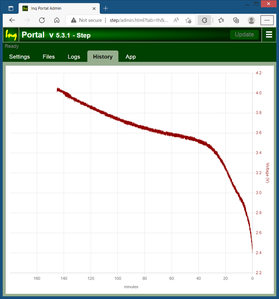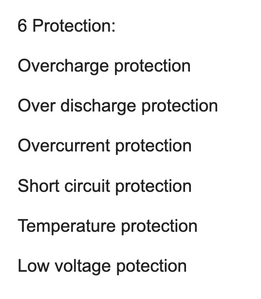Hi All,
For my ESP8266 powered project (several will be placed in the vegetable garden) I have been using NiMH batteries and a step down converter for testing.
I'm considering switching to a single LiFePo4 18650 Cell, but I have never used these before.
My idea is to charge the battery at home and simply change the battery when it's empty (not a problem in this case).
But I guess I also need to monitor the battery level for over-discharging.
Is it a realistic idea to do that using the esp8266 ADC instead of with a BMS like solution?
(turn the device "off" when voltage goes below 2.5 volt)
Thank you, Timo
@timo88 Your best and safest way is to use a TP4056, which does everything needed. Here is one of many possible links LINK
First computer 1959. Retired from my own computer company 2004.
Hardware - Expert in 1401, and 360, fairly knowledge in PC plus numerous MPU's and MCU's
Major Languages - Machine language, 360 Macro Assembler, Intel Assembler, PL/I and PL1, Pascal, Basic, C plus numerous job control and scripting languages.
Sure you can learn to be a programmer, it will take the same amount of time for me to learn to be a Doctor.
Hi All,
For my ESP8266 powered project (several will be placed in the vegetable garden) I have been using NiMH batteries and a step down converter for testing.
I'm considering switching to a single LiFePo4 18650 Cell, but I have never used these before.My idea is to charge the battery at home and simply change the battery when it's empty (not a problem in this case).
But I guess I also need to monitor the battery level for over-discharging.
Is it a realistic idea to do that using the esp8266 ADC instead of with a BMS like solution?
(turn the device "off" when voltage goes below 2.5 volt)Thank you, Timo
Do you have a link for this LiFePO4 18650 Cell? I've never seen one. All 18650's that I know of are LiIon... but I've not really looked into it for several years.
I agree with Ron that the cheap charger board has over and under protection, charges and regulates.
3 lines of code = InqPortal = Complete IoT, App, Web Server w/ GUI Admin Client, WiFi Manager, Drag & Drop File Manager, OTA, Performance Metrics, Web Socket Comms, Easy App API, All running on ESP8266...
Even usable on ESP-01S - Quickest Start Guide
@timo88 Your best and safest way is to use a TP4056, which does everything needed. Here is one of many possible links LINK
Do they make something like this that charges with USB, 5V, stores on one 3.7V 18650 but outputs 3.3V for the micros?
3 lines of code = InqPortal = Complete IoT, App, Web Server w/ GUI Admin Client, WiFi Manager, Drag & Drop File Manager, OTA, Performance Metrics, Web Socket Comms, Easy App API, All running on ESP8266...
Even usable on ESP-01S - Quickest Start Guide
Most of them just take in USB (or 5V), charge the battery to about 4.2V and then feed out the battery voltage to the load. They don't care if it's feeding an MCU or a sensor, their job is done when the battery is charged.
Anything seems possible when you don't know what you're talking about.
@inq That sounds familiar, but I don't know for sure off the top of my head. The problem is twofold, and you will appreciate the second. First, I am in no way knowledgeable enough to know if a part can do what it says, and the second reason is there are too many crooks on the likes of AliExpress or AliBabba, and even Amazon has been caught selling 'fake' goods.
First computer 1959. Retired from my own computer company 2004.
Hardware - Expert in 1401, and 360, fairly knowledge in PC plus numerous MPU's and MCU's
Major Languages - Machine language, 360 Macro Assembler, Intel Assembler, PL/I and PL1, Pascal, Basic, C plus numerous job control and scripting languages.
Sure you can learn to be a programmer, it will take the same amount of time for me to learn to be a Doctor.
@Inq, I found LiFePo4 18650 1500MaH cells on Aliexpress, but you are right 98% is LiIon
@Ron, I think the TP4056 is for LiIon only, I want to use the Tp5000for charging which has an LiFePo4 option.
But I prefer to not add the charger to the device, but use a 18650battery holder and replace the battery.
BTW I think that the Tp4056 and tp5000 boards only charge and don't protect against over discharging?
I found some LiFePo4 BMS boards too which I could use, but as I'm going to measure the battery voltage anyway to send me a message when the battery needs changing, I thought why not use that also as a over discharge protection and switch off the MCU.
@Inq, I found LiFePo4 18650 1500MaH cells on Aliexpress, but you are right 98% is LiIon
Thank you for the link. I've always wondered why the 18650 seemed to always be LiIon and the LiFePO4 batteries seemed to be pouch or bricks. Wondered if it was the something about the chemistry that dictated this or simply convention. This is the first time I've seen such 18650, LiFePO4's. I have ~100 of the 18650 LiIon that I've salvaged from laptop batteries and a 4 kWhr LiFePO4 brick battery in my boat that I prefer the safety factors.
Based on your project, I'd say you're quite familiar with the power utilization issues of the ESP8266. Although I almost exclusively use the ESP8266 in most projects, I've never explored its sleep modes. I tend to drive them full time. I've bookmarked this for future use...
https://hackaday.com/2020/01/15/one-esp8266-one-battery-one-year-and-counting/
But I guess I also need to monitor the battery level for over-discharging.
I once did some experimentation of full-power utilization. I'm sorry to say, either I didn't really document it or I've lost it, but here is what I recall. Maybe you can glean something form these...
Experiment 1 - I just ran an ESP-01S directly from a 18650. I bought 50 of them for experimenting and got them for less than a buck a piece. I expected and can confirm, they didn't tolerate above the 3.7V. 😆 I smoked one at the full 4.2V. Driving (another one) from 3.7, down, I want to say it only lasted about 24 hours, but I don't think you have to worry too much about over-discharging in this scenario. At about 2.6V, the ESP shut down and didn't draw anything. If you're monitoring them anyway for recharging purposes, you'd notice it not working. 😉
I've also used these things - https://www.ebay.com/itm/254464721220 . I'm not a hardware guy, so I don't know if these are the most efficient things for the job. That would be a @davee type question. But for my purposes they're dirt cheap and will utilize a single 18650 over its full range. At which point you would need to monitor for over-discharge. This is easy enough with just a resistor. @inst-tech and others helped me out with this and I've used it in several projects - https://forum.dronebotworkshop.com/postid/28780/ . Just bypass a wire from the positive terminal of the battery through the proper resistor and go to the A0 pin. Voltage monitoring!
Good luck with your project!
Inq
3 lines of code = InqPortal = Complete IoT, App, Web Server w/ GUI Admin Client, WiFi Manager, Drag & Drop File Manager, OTA, Performance Metrics, Web Socket Comms, Easy App API, All running on ESP8266...
Even usable on ESP-01S - Quickest Start Guide
@timo88 I checked your Ali link. Note in some places, it says 3000 cycles, in others 500. They claim it is a protected cell; the attached pics show what protections are built in and capacity conflicts. Given those conflicting claims I would NOT buy those.
I have 7,200 AH of LiFePO4, 3,000 to 5,000 cycles depending on the charging program. My batteries are nominal 12V 100Ah made up of small cylindrical cells that might be these. 4 of these cells in series give 12.8V which might be a match, and 67 in parallel gives 100AH. That would mean I have 268 cells per 100AH battery. Maybe somebody can figure out if that many cells fill a standard 12V 100AH battery size. Genuine 18650 cells are hard to find and there are a lot of fakes on Ali. If you go this route, you need a BMS, and a LiFePO4 charger. The BMS MIGHT be built in. If you go with the more reliable LiPO bag batteries then you need a good quality charger with a BMS like THIS That charger is for charging batteries like THIS
You will also need a pizza stone or similar board to withstand a Lithium fire, and a Lithium charging bag or as I have 2 of them, one smaller inside a larger all on the pizza stone.
One of the benefits of LiFePO4 is they are not at risk of thermal runaway, many RVers store them under their bed. The downside is they are a little less energy dense than laptop or Tesla style chemistry but both those have been involved in fires.
Here is an Amazon listing, note the difference in capacity, price and size, 18500 vs 18650 LINK
This is a very tricky area (18650), and I have more than a few fake cells. Stick with reputable suppliers (Ali is NOT a supplier, it's a collection of suppliers of variable honesty and reliability but Ali will back your purchase with a full refund) BTW, even Amazon may distribute fake cells but also easy returns. eBay is the worst as they contain fakes but no refund policy and expensive shipping.
The LiPO battery market is much more reliable. I just checked the PiShop.ca site and they have 8 different sizes of LiPO bag batteries as well as proper chargers etc.
Be careful and safe.
First computer 1959. Retired from my own computer company 2004.
Hardware - Expert in 1401, and 360, fairly knowledge in PC plus numerous MPU's and MCU's
Major Languages - Machine language, 360 Macro Assembler, Intel Assembler, PL/I and PL1, Pascal, Basic, C plus numerous job control and scripting languages.
Sure you can learn to be a programmer, it will take the same amount of time for me to learn to be a Doctor.
@inq Hmm, right, in this case it's not actually a problem if the MCU switches off, so just a ping "I'm still alive" would do it with something that checks if the ping got received. Thank you for the hints. 🙂
it is a protected cell
Thank you for your reply.
I missed that they are protected TBH, they also have no reviews, which is also not a good thing.
BTW I agree one should be really careful on Ali. But I generally order with the same suppliers on Ali, which works ok.
You will also need a pizza stone or similar board to withstand a Lithium fire, and a Lithium charging bag or as I have 2 of them, one smaller inside a larger all on the pizza stone.
One of the benefits of LiFePO4 is they are not at risk of thermal runaway, many RVers store them under their bed. The downside is they are a little less energy dense than laptop or Tesla style chemistry but both those have been involved in fires.
This is the exact reason I would prefer LiFePo4, but also that there's no need for a step down converter..
The energy density is not a real problem for me, the project will roughly use 150mA for half a second every 2 minutes and not in a remote location.
I did noticed that the majority of the LiFePo4 cells are 32700 cells, maybe that would be a better choice..
@timo88 Yes, for any size of cell like 18650 (180mm long x 65 mm diameter) specific chemistry has a specific capacity, it is not possible to make a 'better' version. Good luck.
First computer 1959. Retired from my own computer company 2004.
Hardware - Expert in 1401, and 360, fairly knowledge in PC plus numerous MPU's and MCU's
Major Languages - Machine language, 360 Macro Assembler, Intel Assembler, PL/I and PL1, Pascal, Basic, C plus numerous job control and scripting languages.
Sure you can learn to be a programmer, it will take the same amount of time for me to learn to be a Doctor.
@timo88 I forgot to mention, the phrase we often use with LiFePO4 is 'give em hell'. This chemistry is extremely robust. The only negative is do NOT charge them below 24F, although most designers set the BMS to 0C which is 32F for a safety margin. They can still be used/discharged down to -4F which is -15C.
Also, battery life will be extended if you do NOT keep them fully charged, let them cycle normally and regularly from 100% down to at least 70% and all the way to 10% or even lower.
You will hear advice that is counter to what I have said, this is fake news put out by the lead lobby, my advice comes from the people who built and guarantee my batteries for 8 years of replacement and 10 years prorated from the normal 80%. At the moment, my batteries are about 3 years old and are still able to cycle thru the full 95% to 70% cycle I have programmed. My old FLA batteries would need replacement now.
The specs tell the story, a Lead Acid battery is good for 500 cycles max, a LiFePO4 is good for 3,000 at least and 5,000 is commonly reached.
First computer 1959. Retired from my own computer company 2004.
Hardware - Expert in 1401, and 360, fairly knowledge in PC plus numerous MPU's and MCU's
Major Languages - Machine language, 360 Macro Assembler, Intel Assembler, PL/I and PL1, Pascal, Basic, C plus numerous job control and scripting languages.
Sure you can learn to be a programmer, it will take the same amount of time for me to learn to be a Doctor.




